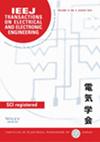求助PDF
{"title":"Analysis of Communication Performance for Head-Mounted Wearable Device","authors":"Zhu Xiong, Wei Liao","doi":"10.1002/tee.70063","DOIUrl":null,"url":null,"abstract":"<p>To study the channel characteristics and communication performance in the low-frequency UWB band for head-mounted devices, this paper uses the finite difference time domain method, combined with the electromagnetic properties of human tissues, to establish a human head model. It proposes a head transmission system under the low-frequency UWB band, exploring the multipath propagation phenomena during communication. The effects of multipath caused by the human body on communication characteristics are analyzed through power delay distribution, first path power gain, and inter-path delay. The model is validated using the root mean square delay spread; additionally, the feasibility of the head-mounted wearable model is evaluated from the perspective of human safety. The results show that the multipath power delay of the left ear to right ear communication link decays exponentially over time, the power gain changes follow a normal distribution, and the inter-path delays follow a logistic distribution, with an average inter-path delay of 2.75 ns and a standard deviation of 1.25 ns. The cumulative distribution function of the multipath delay spread conforms to an inverse Gaussian distribution, and the peak specific absorption rate of 0.00087 W/kg is significantly lower than the 2 W/kg limit set by the ICNIRP guidelines. © 2025 Institute of Electrical Engineers of Japan and Wiley Periodicals LLC.</p>","PeriodicalId":13435,"journal":{"name":"IEEJ Transactions on Electrical and Electronic Engineering","volume":"20 11","pages":"1766-1772"},"PeriodicalIF":1.1000,"publicationDate":"2025-05-20","publicationTypes":"Journal Article","fieldsOfStudy":null,"isOpenAccess":false,"openAccessPdf":"","citationCount":"0","resultStr":null,"platform":"Semanticscholar","paperid":null,"PeriodicalName":"IEEJ Transactions on Electrical and Electronic Engineering","FirstCategoryId":"5","ListUrlMain":"https://onlinelibrary.wiley.com/doi/10.1002/tee.70063","RegionNum":4,"RegionCategory":"工程技术","ArticlePicture":[],"TitleCN":null,"AbstractTextCN":null,"PMCID":null,"EPubDate":"","PubModel":"","JCR":"Q4","JCRName":"ENGINEERING, ELECTRICAL & ELECTRONIC","Score":null,"Total":0}
引用次数: 0
引用
批量引用
Abstract
To study the channel characteristics and communication performance in the low-frequency UWB band for head-mounted devices, this paper uses the finite difference time domain method, combined with the electromagnetic properties of human tissues, to establish a human head model. It proposes a head transmission system under the low-frequency UWB band, exploring the multipath propagation phenomena during communication. The effects of multipath caused by the human body on communication characteristics are analyzed through power delay distribution, first path power gain, and inter-path delay. The model is validated using the root mean square delay spread; additionally, the feasibility of the head-mounted wearable model is evaluated from the perspective of human safety. The results show that the multipath power delay of the left ear to right ear communication link decays exponentially over time, the power gain changes follow a normal distribution, and the inter-path delays follow a logistic distribution, with an average inter-path delay of 2.75 ns and a standard deviation of 1.25 ns. The cumulative distribution function of the multipath delay spread conforms to an inverse Gaussian distribution, and the peak specific absorption rate of 0.00087 W/kg is significantly lower than the 2 W/kg limit set by the ICNIRP guidelines. © 2025 Institute of Electrical Engineers of Japan and Wiley Periodicals LLC.
头戴式可穿戴设备通信性能分析
为了研究头戴式设备在低频UWB频段的信道特性和通信性能,本文采用时域有限差分法,结合人体组织的电磁特性,建立了人体头部模型。提出了一种低频UWB频段的头部传输系统,探讨了通信过程中的多径传播现象。从功率延迟分布、首路功率增益和径间延迟三个方面分析了人体引起的多径对通信特性的影响。利用均方根时延扩展对模型进行了验证;另外,从人身安全角度对头戴式可穿戴模型的可行性进行了评估。结果表明:左耳到右耳通信链路的多径功率延迟随时间呈指数衰减,功率增益变化服从正态分布,径间延迟服从logistic分布,平均径间延迟为2.75 ns,标准差为1.25 ns。多径延迟扩展的累积分布函数符合反高斯分布,峰值比吸收率为0.00087 W/kg,显著低于ICNIRP指南设定的2 W/kg限值。©2025日本电气工程师协会和Wiley期刊有限责任公司。
本文章由计算机程序翻译,如有差异,请以英文原文为准。


 求助内容:
求助内容: 应助结果提醒方式:
应助结果提醒方式:


